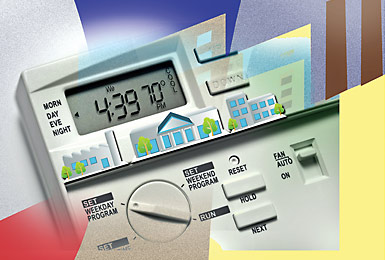Energy Management Demand Response Difficult to Implement
Although Demand Response systems can help commercial building owners monitor and manage energy demand, these programs have proven difficult to implement.
Winter 2011

The promise and hype surrounding the smart grid far exceeds its current capabilities. The commercial building sector, at which many DR programs are targeted, comprises 20 percent of energy demand and emissions in the United States. These concentrated pools of demand are a nightmare for strained utility grids, especially in major cities. As a result, utilities have created DR programs to provide financial incentives for building owners to reduce energy consumption during peak periods. But why would utilities pay end users to reduce power? The alternative is to build more power plants, which will cost the industry billions down the road.
The commercial building sector looks forward to the prospect of DR and the benefits that accompany it, namely reducing electrical demand during peak periods, which may result in monetary rewards for the customer.
Implementing Demand Response
As with anything, fundamental issues have limited and will continue to limit the success of these programs as they are rolled out. The most significant challenges include:
• The risk to tenant service levels posed by DR events;
• The execution complexities of intelligently managing through DR events, especially in large, complex buildings; and
• The capital requirements to fund the people or systems to ensure building owners and managers can address these issues.
Despite the potentially huge scale of DR programs, current technologies and systems that help utilities and the commercial building sector execute DR programs are surprisingly rudimentary. We'll call it "Manual DR." Some of the challenges with the current technologies are:
• Manual DR signals - emails, phone calls, text messages - from the utility or DR aggregator to a building manager to let them know a DR event is coming,
• Manual changes to energy systems (the building manager turning off lights or an HVAC chiller) to execute maximum load reduction,
• Limited ability to estimate load reduction quantity occurred versus target,
Limited ability to predict or determine effect on tenant comfort from the changes in the response, and
• Bill reconciliation and credit in 60-90 days when the utility collects and processes data.
How can building owners confidently participate in DR events this way? How can a utility build a scalable, effective DR program for thousands of customers? They can't. Commercial building owners and utilities say that the commercial sector has not been adopting DR programs to the expected extent. I recently spoke with one of the top five direct property investors in the world, and he noted that the company had only one building in the United States on a DR program, since that was the only facility with a building manager who knew the building and its systems well enough to manage an event. (Since that conversation, they have stopped participating.)
This lack of adoption is one of the biggest reasons utilities introduce a Peak Day Price (PDP) tariff program, which charges 10-15 times the normal rates during peak periods. Unlike voluntary incentive programs, large commercial customers are automatically moved onto the PDP program unless they opt out by adopting another DR plan.
Project Announcements
Hoffman & Hoffman Expands Greensboro, North Carolina, Headquarters Operations
12/24/2025
Fenner Precision Polymers Plans Gaffney, South Carolina, Manufacturing Operations
12/24/2025
Mission Critical Interior Solutions Plans Springfield, South Carolina, Manufacturing Operations
12/24/2025
INCOG BioPharma Services Plans Fishers, Indiana, Manufacturing Operations
12/24/2025
Beckwood Press Expands Fenton, Missouri, Headquarters Operations
12/23/2025
Uzbekistan-Based AKFA Aluminum Solutions Plans Bowling Green, Kentucky, Production Operations
12/23/2025
Most Read
-
The Workforce Bottleneck in America’s Manufacturing Revival
Q4 2025
-
Rethinking Local Governments Through Consolidation and Choice
Q3 2025
-
Lead with Facts, Land the Deal
Q3 2025
-
Investors Seek Shelter in Food-Focused Real Estate
Q3 2025
-
Tariff Shockwaves Hit the Industrial Sector
Q4 2025
-
America’s Aerospace Reboot
Q3 2025
-
The Permit Puzzle and the Path to Groundbreaking
Q3 2025